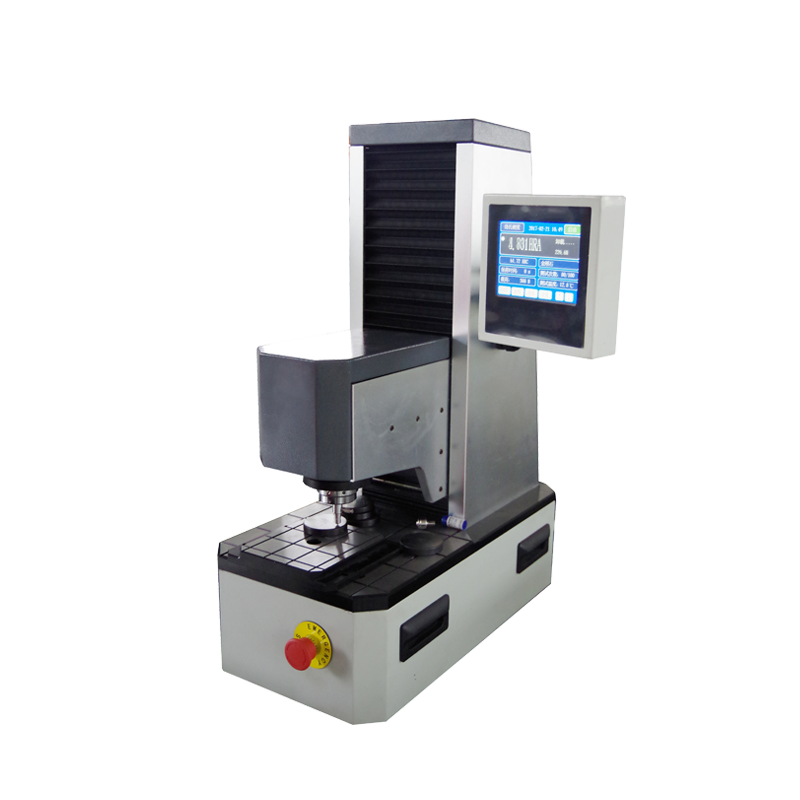


Mitech MHRS-150-XYZ Automatic Rockwell Hardness Te
Mitech
HRA:20-88、HRB:20-100、HRC:20-70、HRD:40-77、 HRE:70-100、HRF:60-
550*320*750mm
76*48*85cm
100kg
Product
 Overview
Overview Graphic
Graphic Technical
Technical Configuration
Configuration Related
Related
Product
- Overview
- Graphic
- Technical
- Configuration
- Related
-
 Product Overview
Product OverviewMitech MHRS-150-XYZ automatic Rockwell hardness tester, based on the mechanical principle of conical diamond or hard alloy indenter pressing into the sample surface to produce indentation, realizing the material hardness measurement by measuring the depth of the indentation. With high automation degree, accurate measurement, equipped with automatic turret and high sensitivity touch screen, it can ensure automatic loading and unloading of electronic, automatic indentation marks, automatic generation of inspection reports and other functions. With easy operation and high detection efficiency, it can meet the needs of workpiece sample hardness control and conformity assessment of hardness testing. It is widely used in metal processing and manufacturing, various metal material’s failure analysis and other fields like colleges and research institutions. it is the professional precision testing equipment to improve the work efficiency, product qualification rate and save production costs.
 Function & application
Function & applicationl Used for quality control in metal processing manufacturing;
l Used for failure analysis testing of metallic materials;
l Demonstration experiment for education and teaching in Colleges and Universities;
l Hardness testing of materials in scientific research institutions.
 Working Principle
Working PrincipleThe Rockwell hardness test is taking the diamond cone with 120°apex angle or the hardened steel ball with specified diameter as the indenter to press into sample surface with specific test force, then get the Rockwell hardness of the measured metallic materials according to the sample surface indentation depth.
The Rockwell hardness measurement principle is shown as below figure. 0-0 is the position that the diamond indenter is not yet in contact with the sample. 1-1 figure is the indenter position under the affect of the preliminary test force, the indentation depth is h1. The preliminary test is to eliminate the influence to the testing result accuracy caused by the roughness of the sample surface. 2-2 in the figure is the indenter position under the influence of the testing force (the preliminary test force and the main test force). The depth is h2. 3-3 in the figure is the indenter position after dismounting the main test force. As the metal elasticity will recovery some degree after deformation, the really indentation depth of the indenter is h3. The plastic deformation caused by the main test force make the indenter pressing into the depth is h=h3-h1. Rockwell hardness value is determined by the size of h, the greater the depth h, the lower the hardness, otherwise, the higher the hardness.
In the traditional concept, usually use a constant C minus h to represent the level of hardness, while the depth of indentation per 0.002mm as a unit of hardness. The hardness value obtained is called the Rockwell hardness value, denoted by the symbol HR.
In the formula, c is a constant (for HRC, HRA, c is 0.2; for HRB, c is 0.26). The Rockwell hardness value HR obtained is an unknown number which is usually read directly on the test machine indicator when testing.It should be noted that the measured hardness values would be different with different indenter and test force. Therefore, the Rockwell hardness testing specifies 15 different hardness test scales according to the different indenter specification and test force sizes. And the HRB, HRC, HRA are the most widely used.
 Working Conditions
Working Conditionsl Operation Temperature:10~30℃;
l The surrounding environment should avoid of vibration, strong magnetic field, corrosive medium and heavy dust.
 Instrument Features
Instrument Featuresl Widely used for high-precision hardness testing for parts with a variety of metal and non-metallic materials;
l High degree of automation, accurate measurement, suitable for large demand or high precision measurement of high-end
users;
l Automatic operation with one-button, measuring pressure can be adjusted up and down, instant display material hardness
value,and high test efficiency;
l Measurement data files can be set to automatically store, open, store, print, modify, call and other operations, generate
word or Excel test report;
l Adopt touch screen display interface, display operation integration, simple and intuitive, no technical requirements for the
operator;
l Option for various specifications of the indenter, support 15 types of Rockwell hardness scales testing;
l Equipped with high-speed thermal printer, quickly print out the test data;
l Support the conversion among various hardness scales such as Brinell, Vickers and etc;
l Equipped with excellent performance of cemented carbide or diamond indenter, high hardness, wear resistance, good
toughness, with high temperature, corrosion resistance, to ensure that the instrument test value is accurate, stable and
reliable;
l With the function of error value correction, the hardness value of the error can be corrected by key input, easier to meet
the test accuracy requirements;
l With the function of threshold overrun automatic alarm, apply to the bulk of finished products or semi-finished pieces of
paper-by-piece detection;
l Original ambient temperature real-time display function, to avoid the instrument working in the case of high or low
temperature for a long time, resulting in increased test error and reduce the service life;
l Consistent with EN-ISO-6508、GB/T230.1、GB/T230.2、JJG112、ASTM E18 and other relevant standards at home and
abroad.
 Operating Method and Attentions
Operating Method and Attentions Instrument Maintenance
Instrument Maintenancel The test personnel should follow the operating procedures.Before and after the test,it should be repeated with standard
block calibration equipment;
l If the specimen has visible deformation marks on the back and edges, the test result would be useless. It should choose
the intender or test force to test again;
l Normally, the first point is only used to offset the gap of each support surface without needing to record the test result.
Record the statistical test result from the second point;
l During testing, to ensure accuracy, please make sure the distance between the adjacent indentation center and the
distance from the indentation center to edge of the specimen is greater than 3mm;
l Pay attention to palm the instrument for carrying to forbid falling across. Please fix well the measuring lever, counterweight
and boom before carrying;
l It is strictly prohibited to turn the variable loading handwheel when the instrument load or unload the test force. Rotating
the handwheel forcibly will cause the internal gear dislocation, test force in chaos and even damage the internal parts of
the instrument;
l Turn off the power after using the instrument. When not in use for a long time, please cover the dust cover to prevent
dust into the instrument interior. And the hardness block, indenter should be coated with antirust oil to prevent rusting
after using;
l Long time after the re-enabled,it should be preheated the electrical components before test
l The hardness tester should be calibrated at least once a year to ensure its accuracy;
l Don’t disassemble the instrument without authorization, for maintenance related matters, please contact MITECH
after-sale service department with 4000600280.
-

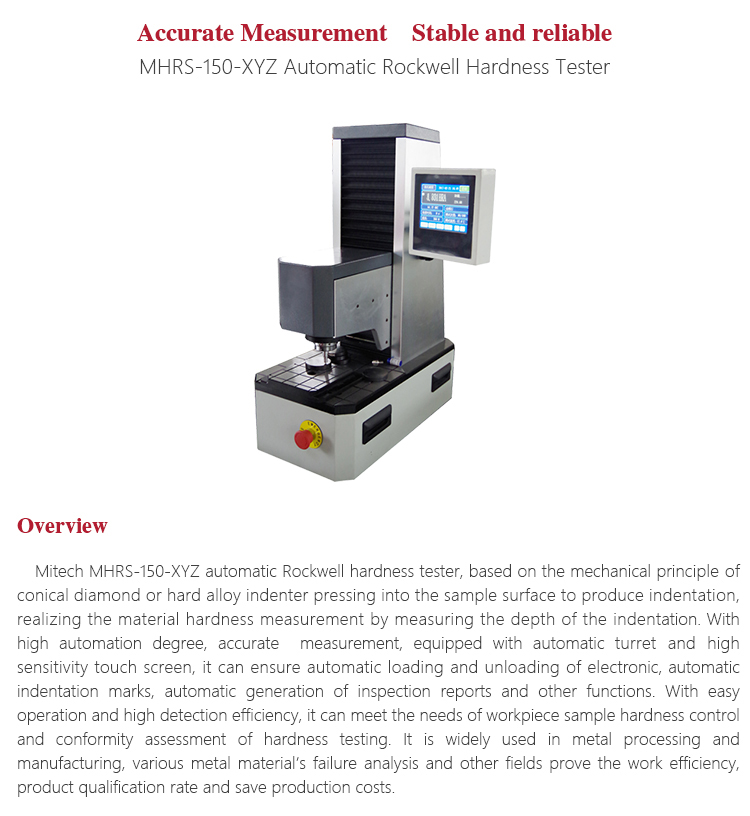
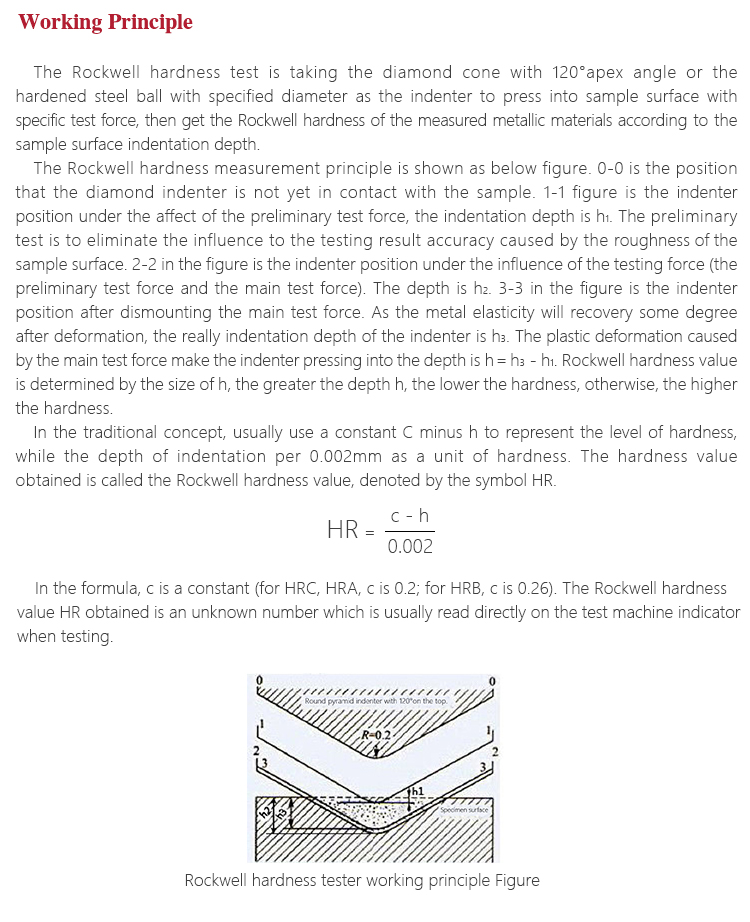
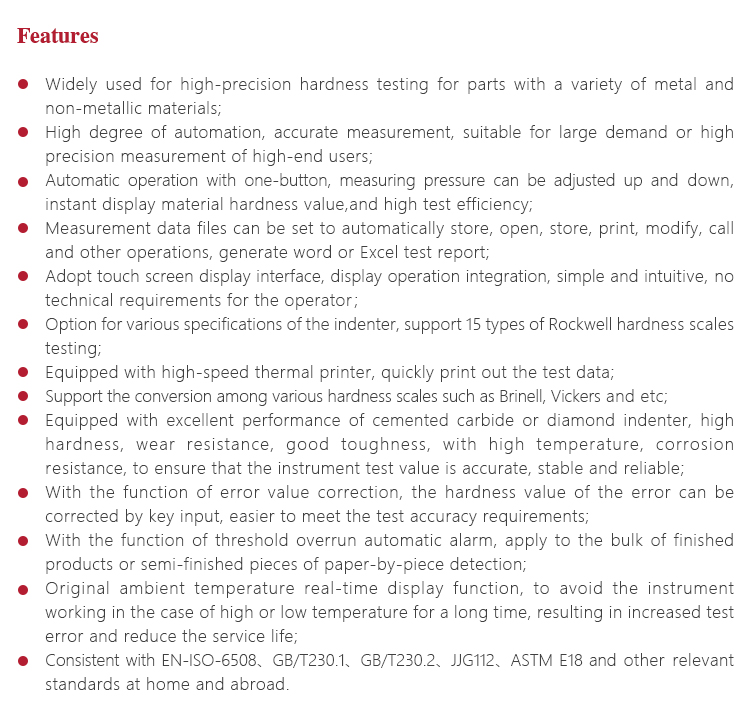
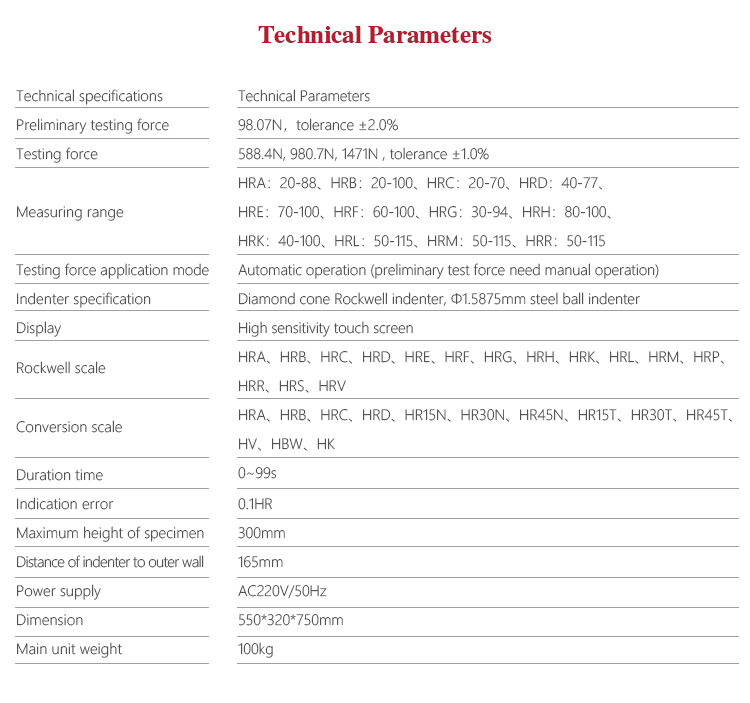
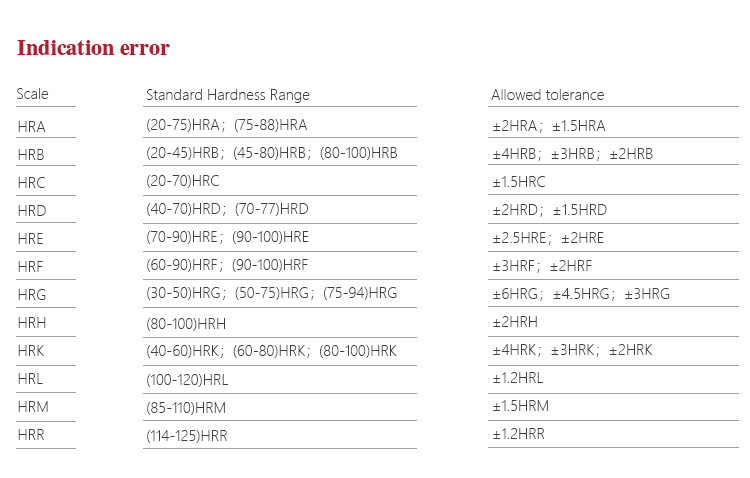
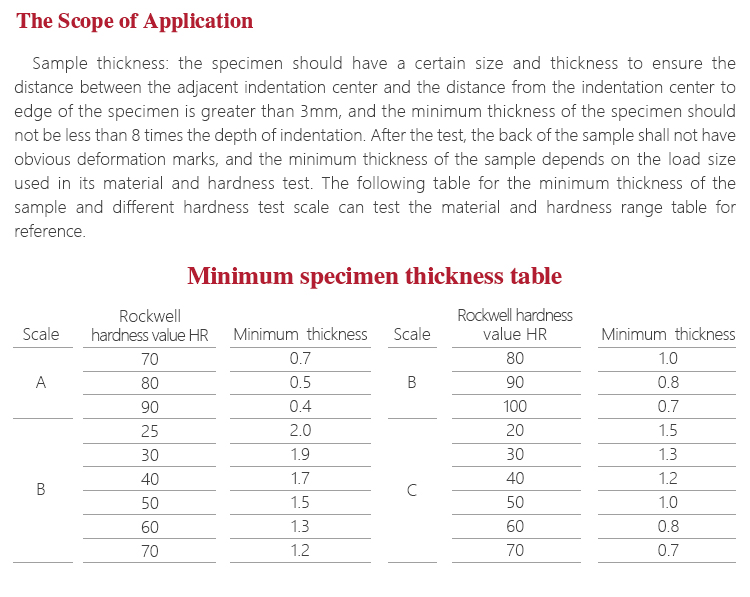
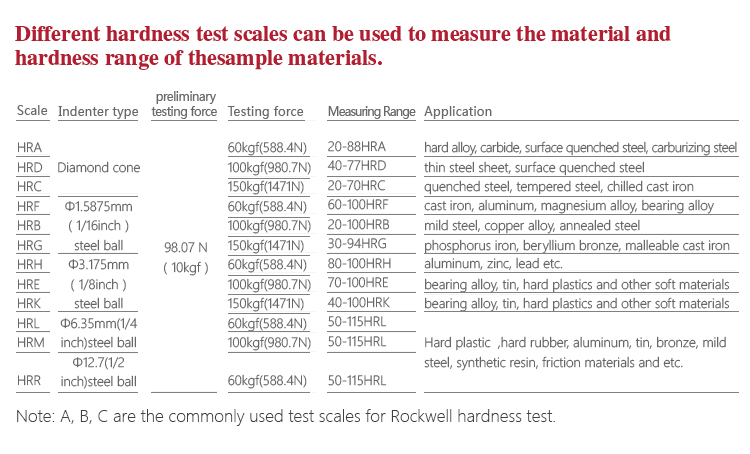
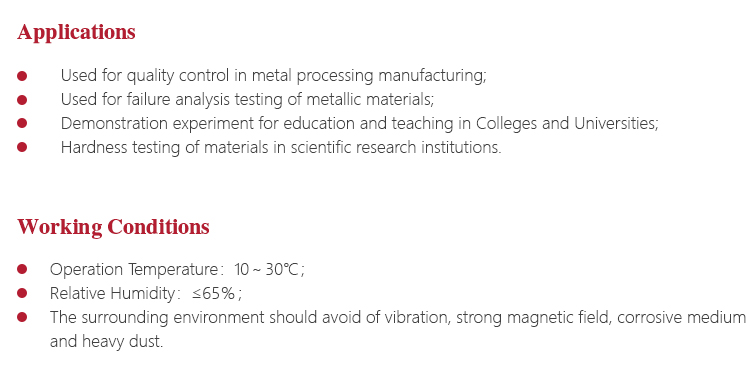

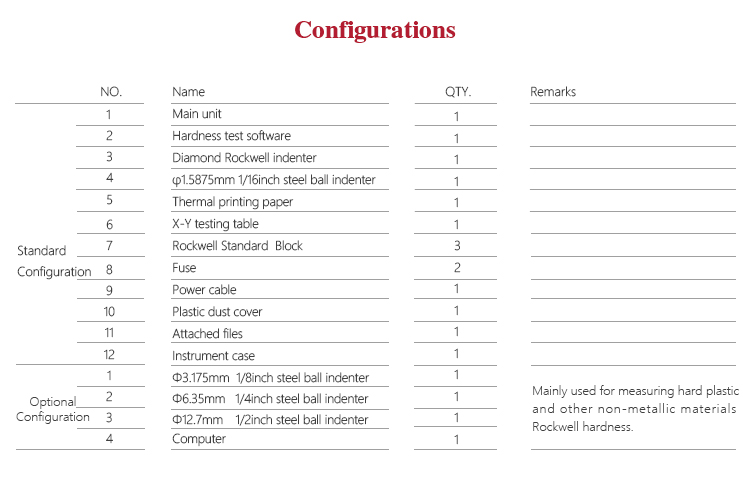
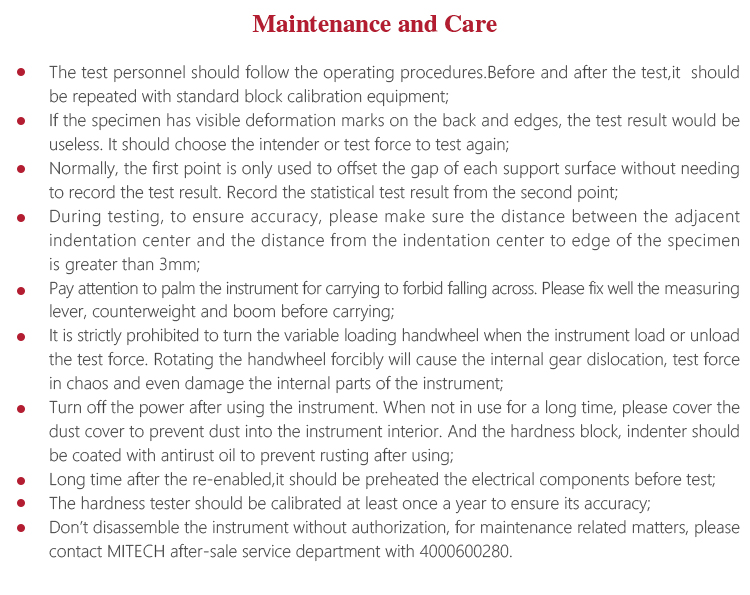
-
Preliminary testing force 98.07N,tolerance±2.0% Testing force 588.4N,980.7N,1471N,tolerance±1.0% Measuring range HRA:20-88、HRB:20-100、HRC:20-70、HRD:40-77、 HRE:70-100、HRF:60-100、HRG:30-94、HRH:80-100、 HRK:40-100、HRL Testing force application Mode Automatic operation (preliminary test force need manual operation) Indentor specification Diamond cone Rockwell indenter, Φ1.5875mm steel ball indenter Display High sensitivity touch screen Rockwell scale HRA、HRB、HRC、HRD、HRE、HRF、HRG、HRH、HRK、HRL、HRM、HRP、HRR、HRS、HRV Conversion scale HRA、HRB、HRC、HRD、HR15N、HR30N、HR45N、HR15T、HR30T、HR45T、HV、HBW、HK Duration time 0~99s Indication error 0.1HR Maximum height of specimen 300mm Distance of indenter to outer wall 165mm Power supply AC220V/50Hz Dimension 550*320*750mm Main unit weight 100kg -
-







